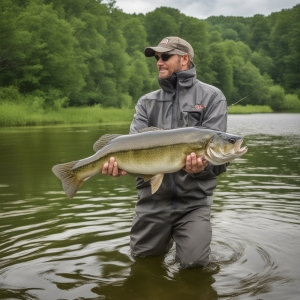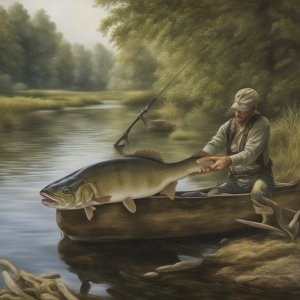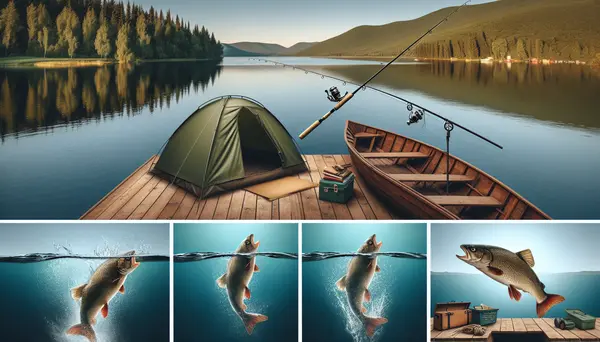Table of Contents:
Introduction to Bass Fishing
Bass fishing is a fascinating and engaging activity vastly enjoyed by many anglers. There are two main species to focus on, and they are the Largemouth and Smallmouth Bass. Both offer a thrilling experience due to their energetic behaviour and weight. As a result, they are considered prized catches among the angling community.
Bass fishing isn't just casting your line and waiting; it requires strategy, understanding the habits of the bass and employing the correct techniques. This article acts as a beginner's guide, bursting with quintessential knowledge to help harmonize your efforts with these formidable fishes.
Understanding Largemouth and Smallmouth Bass
The first step to effective bass fishing is understanding the key differences between Largemouth and Smallmouth Bass. Although they belong to the same family, they exhibit distinct behaviors, habitats, and feeding patterns which directly influence your strategy for catching them.
Typically, Largemouth Bass are found in warmer, stagnant, or slow-moving waters with a lot of vegetation. They prefer to stay near structure like fallen trees, weeds, and rocks where they can surprise their prey. On the other hand, Smallmouth Bass thrive in colder, clearer water, especially in rocky areas or river systems with strong current. They are also generally more aggressive and energetic than their largemouth cousins.
When it comes to feeding, both species are opportunistic feeders. Largemouth Bass diet primarily consists of smaller fish, insects, and crustaceans. In contrast, Smallmouth Bass, while also preying on similar food sources, have been noted to have a particular fondness for crayfish.
Pros and Cons of Different Bass Fishing Strategies
| Strategy | Pros | Cons |
|---|---|---|
| Use of Live Baits | Highly effective as they are the bass's natural prey | May be expensive and require proper care |
| Spinnerbait Techniques | Can cover a lot of water fast and mimic a variety of prey | Too flashy for many conditions, requires skill to use |
| Fishing with Plastic Worms and other soft plastics | Versatile and can be effective in various conditions | Easily damageable requiring frequent replacement |
| Deep Sea Fishing | Chance of catching larger species | Requires expensive equipment and detailed knowledge about water depth and fish habits |
Locating Ideal Bass Fishing Spots

Locating the perfect spot is pivotal to your bass fishing successes. Search for an area that appeals to the bass’s habitual needs. For Largemouth Bass, this means sheltered and vegetative locations. Look for areas rich with lily pads, cattails and reeds, submerged trees or man-made structures like bridges or docks. These offer plentiful cover for Largemouth Bass, creating terrific opportunities for action.
For Smallmouth Bass, you should turn your sights to rocky points, sandy bars and river systems with rapid current. Rushing water tends to bring food with it, and you'll often find Smallmouth Bass hunting in these areas. The presence of small fish, crayfish and other baits can also hint at the presence of Smallmouth Bass in the vicinity.
Bass also tend to be more active during specific times of the day. Typically, you'll have the most luck in the early morning or late evening, when the bass are out feeding. Observation coupled with patience is key.
Equipments Necessary for Bass Fishing
The appropriate fishing gear is essential to enhance your chances of successfully reeling in both Largemouth and Smallmouth Bass. Let's dive into the key components of your bass fishing equipment kit.
Firstly, you should invest in a high-quality rod and reel. Bass are known to put up a fight, and a robust rod will help to land your catch. For the reel, baitcasting or spinning types work well. The choice between the two largely depends on your level of comfort using them.
Next comes the line. Braided lines are touted for their strength and durability, making them a top pick for bass fishing. A 10 to 15-pound test line should suffice for most situations. However, it's wise to adjust according to the size of bass you are targeting and the nature of the waters.
As for the lures, both artificial and live baits can be used. Plastic baits such as craws or worms are effective for Largemouth Bass who prefer slower, more methodical movement. As Smallmouth Bass are more energetic, crankbaits or spinnerbaits that move swiftly in the water could be more tempting to them.
Equipping yourself with necessary tools such as pliers, line cutters, and a good tackle box will be beneficial in the long run. Also, a fishing vest with multiple pockets serves as a convenient storage option during your fishing trip.
In the grand scheme of bass fishing, knowledge about your desired catch’s preference and applying that to your selection of gear goes a long way. Thus, choosing the right equipment increases your chances of a fruitful bass fishing experience.
Effective Strategies for Catching Largemouth Bass

When catching Largemouth Bass, taking note of the water temperature and conditions of your chosen fishing spot is critical. Largemouth Bass are sensitive to temperature changes and tend to be more active in warmer waters. They also prefer clear water conditions, which allow them to predict and track down their prey.
Casting your line in areas where the bass are likely to be hiding increases your chances of catching one. As stated earlier, Largemouth Bass tend to stay close to structures such as fallen trees or vegetation. Among the most effective strategies is the "flipping and pitching" technique. This approach involves presenting your bait in a discreet and non-intrusive manner, a tactic that works masterfully in areas where Largemouth Bass seek refuge.
Choosing the right bait for Largemouth Bass can significantly improve your success rate. Rubber worms and other soft plastic baits that mimic their natural prey are good choices. Largemouth Bass are visual hunters and are more likely to strike baits that realistically mimic their prey's movement patterns. Therefore, mastering the retrieval technique of your desired bait is also key.
Moreover, maintaining an element of surprise is vital. Try to be as silent and still as possible to avoid startling the Bass. Avoid casting a shadow over the water or creating excessive noise as it can deter the Bass from your bait.
Effective Tactics for Smallmouth Bass Fishing
Smallmouth Bass, the more active cousin of the Largemouth Bass, requires a different set of strategies to reel in. These feisty fish are attracted to rocky areas and swift current river systems. Therefore, fishing in such environments around dawn, dusk, or after a good shower of rain can produce bountiful results.
Pay close attention to water clarity. Smallmouth Bass prefer clearer waters where they can easily spot and chase down food. When it comes to temperatures, these fish are cold-water enthusiasts. They are most active in cooler temperatures between 60 to 70 degrees Fahrenheit.
For lures, crankbaits and spinnerbaits work wonders due to their mimicking of a wounded small fish, an irresistible treat for a Smallmouth Bass. You could also use soft plastic lures like grubs or tubes resembling their favorite crayfish. Remember, the key is to make your bait move as naturally as possible.
Another important tactic is the cast-and-retrieve method. This involves casting your bait into potential bass hotspots and then systematically retrieving it. This simulation of prey movement can trigger the predatory instincts of the Smallmouth Bass. Vary your retrieval speed, direction and pauses to mimic natural prey activity.
The combination of understanding Smallmouth Bass behavior, their preferred environment, and tailor-made tactics are central to your success. With patience, knowledge and the right equipment, you will be well on your way to mastering the art of Smallmouth Bass fishing.
Safety Tips for Bass Fishing

Safety matters regardless of whether you are a seasoned angler or a rookie. First and foremost, it is crucial to wear a life jacket or a personal flotation device (PFD) while fishing. Unexpected situations can occur, and it's better to be safe, especially when you're near or on the water.
Another important tip is to be aware of your surroundings. Keep a safe distance from other anglers to prevent any accidents that might arise from casting the fishing line. Also, be cautious about the local wildlife. Some areas might have potentially harmful animals living nearby.
Bass fishing often involves sharp objects such as fish hooks, knives, and other tackle. Handling these objects with care will prevent any unnecessary injuries. It can be useful to carry a first-aid kit for treating minor cuts and wounds immediately.
Finally, always ensures someone knows where you are going and when you are expected to return. In case of an emergency, this information is crucial so rescuers can find you quickly.
Remember, a successful bass fishing trip is not only about the quantity or size of your catch. It should also prioritize safety, leaving you with pleasant memories and stories to share.
Conservation of Bass - A Call to Anglers
As we delve deeper into the captivating world of bass fishing, it becomes essential to discuss an aspect just as vital, if not more so, than learning strategies and techniques - the conservation of bass. This idea transcends enhancing your fishing experience and leans into ethical angling, preserving these fascinating species for future generations to enjoy.
Responsible angling goes far beyond the catch and release principle. It encompasses considerations about the overall well-being of the fish and the environment they inhabit. Check out the following practices that every respected angler should adopt:
First and foremost, familiarize yourself with the local fishing regulations. These rules often dictate the fishing seasons, catch limits, and minimum size requirements. Adhering to these guidelines not only safeguards the bass population but also helps to maintain a balanced ecosystem.
Practicing proper handling techniques is another vital point. To reduce stress and potential injury to the fish, minimize their time out of water. Use barbless hooks or those made out of high-carbon steel, which eventually dissolve if left in the fishs mouth. Avoid handling the fish with dry hands, as this can remove their protective slime layer that shields them against infections and diseases.
Lastly, showing respect towards the environment is crucial for bass conservation. Ensure to clean up your fishing area and don't leave any fishing lines or hooks behind. Be aware of the impacts of invasive species, both plants and aquatic life, and do not transport them from one water body to another.
As the saying goes, the future of our fishing is in our hands today. By practising ethical bass fishing, we can contribute significantly to the conservation of these remarkable species, securing their survival for the anglers of tomorrow.
Conclusion and Final Thoughts on Bass Fishing
With the knowledge and strategies provided in this article, you are now well-equipped to step into the enchanting world of bass fishing. Remember, bass fishing goes beyond just the catch; it’s a thrilling journey that incorporates observation, patience, and strategy.
As with any skill, practice is crucial to improving your angling finesse. The more time you spend on the water, the more aware you become of the subtleties of both Largemouth and Smallmouth Bass behavior. This awareness, in addition to aptly choosing your fishing gear, can remarkably enhance your bass fishing success and experience.
Don't forget to cherish the serene moments that nature provides while you're on the quest for that perfect catch. Let the thrill of the pursuit, the strategizing, and, not to forget, the triumphant catch, be an enjoyable and enriching experience. It's clear that bass fishing is a rewarding pastime, filled with opportunities to learn and grow as an angler.
We hope this 'Bass Fishing 101' guide has proven to be valuable in lending insights into what lies in store on your bass fishing ventures. Here's to wishing you many memorable moments and triumphant catches on the water. Tight lines!
FAQ to Mastering Bass Fishing
What equipment do I need for bass fishing?
You'll need a medium-heavy rod, a bait casting reel, and a variety of lures including plastic worms, jigs, and crankbaits. Always have a fish landing net and a set of fishing pliers too.
Where do largemouth and smallmouth bass usually live?
Largemouth bass tend to live in warmer, shallower water with ample cover like plants or submerged structures. Smallmouth bass prefer cooler, deeper water and rocky structures.
What's the best season for bass fishing?
Spring is regarded as the best season because it's the bass spawning season which makes them more aggressive and easier to lure.
What lures should I use to catch largemouth and smallmouth bass?
For largemouth bass, plastic worms, spinnerbaits, and jigs can be effective. For smallmouth bass, try tube baits, spinners, and small crankbaits.
What are some strategies for catching more bass?
Some strategies include understanding bass behavior, mastering various casting techniques, learning to read water, and varying your lure presentations.







